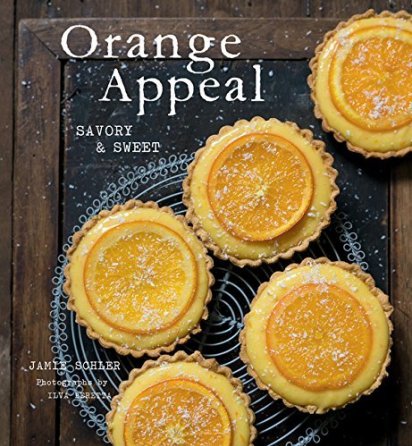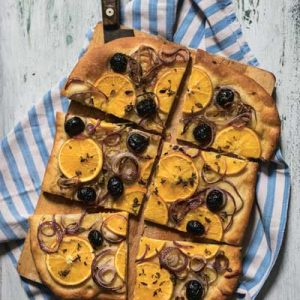Ramadan Mubarek — wishing you a blessed Ramadan. Whatever your faith, or even lack of faith, spring is the time for renewal, reflection, rededication to who we want to be. All over the world, Muslims fast each day of Ramadan. That means a daily fast for 30 days.

Fasting wigs my husband out, but I do it at Yom Kippur — and, not intentionally, when I have a crazy day. Fasting with intention is better. It expands awareness, empathy — all those good human qualities. It reconnects you with your physical self even as it makes you feel more connected to the world around you. And it makes you feel grateful. How can you appreciate food when you don’t experience hunger?

The fast ends at sundown, traditionally with olives and dates, restorative foods revered in both the Qur’an and the Bible. This olive and orange focaccia from Jamie Schler’s book, Orange Appeal is a beautiful way to break a fast or just to celebrate spring. Jamie is Florida-born — hence the orange obsession. We’d been Twitter friends and cooking colleagues for ages, but only met IRL pre-Covid, when I visited her at her charming inn in Chinon. As the Moroccan saying goes, by bread and salt we are united.
Check out Jamie’s website, Life’s a Feast and her podcast, Stir Crazy.

Savory Orange, Onion, and Olive Focaccia
Ingredients
- 1 1/2 tablespoons granulated white sugar
- 2 1/2 teaspoons 1/4 ounce / 7 g active dry yeast
- 1 1/4 cups 315 ml warm water, divided
- 4 cups 19 ounces / 540 g all-purpose flour, divided, plus more for kneading
- 2 teaspoons salt
- 3 oranges finely zested, about 1 1/2 tablespoons
- 4 tablespoons olive oil divided
- 1 to 2 oranges
- 1 to 1 1/2 yellow or red onions
- 1 cup 100 g cured black, green, or purple olives
- Sea salt flakes preferably smoked, coarse salt, or Orange Salt (page 22)
- Freshly ground black pepper to taste
- Fresh oregano or thyme leaves optional
Instructions
- Place 3 3/4 cups (500 g) of the flour, salt, and zest in a large mixing bowl and rub together with your fingers until blended and there are no clumps of zest; make a well in the center of the flour. Pour 2 tablespoons oil, the yeast mixture, and remaining water into the well and stir with a wooden spoon until a rough dough forms; if there are any pockets of flour that won’t blend in, add 1–2 tablespoons more warm water at a time, only as needed.
- Turn the dough out onto a lightly floured work surface and knead in the remaining 1/4 cup (40 g) flour. Knead the dough for 6 minutes, dusting both the dough and the work surface lightly with more flour to keep the dough from sticking. The dough should be soft, smooth, and elastic.
- Oil a large, clean mixing bowl with 1 tablespoon of the oil. Place the ball of dough in the bowl, turning to coat the surface of the dough with oil. Cover the bowl with plastic wrap and a kitchen towel and let rise for 1 hour until double in size.
- Prepare the toppings by peeling the oranges, cutting away all the white pith, and slicing across the core into 1/4-inch (1/2 cm) slices, about 6 slices per orange. If you prefer, slice each round into 4 triangles. Peel and trim the onion and slice as thinly as possible—cut the onion in half if easier—separating the slices into rings.
- Preheat oven to 400 degrees F (200 degrees C).
- Scrape the risen dough onto a lightly floured work surface and roll out into a 10 x 14-inch (25 x 35 cm) rectangle. Transfer to a parchment-lined baking sheet and roll and press back into shape. If you like, use wet fingertips to make indentations across the surface of the dough where a little oil can pool. Brush dough with remaining 1 tablespoon oil and arrange the oranges on the surface; pressing gently into the dough. Spread the onions evenly over the focaccia. Dot with the olives, pressing firmly into the dough, and dust with salt, pepper, and oregano. Bake for 30–40 minutes until risen and golden.

Leave a Reply